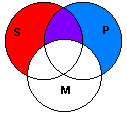Never said he wasn't so I don't get the "Now," reference.
Venn Diagram:
The Example is represented by this diagram, where "S" represents the fideism, "P" represents rationalism and "M" represents knowledge about God.
Fideism Claims S and only S. It excludes P.
Hegel perhaps is making a strong case for S not being necessary. Certainly the scholastics are making that case.
I continue to suggest S can lead to M and have claimed so all along, P can lead to M, and Jesus and the Apostles give us examples of P leading to M.
Finally, I think that the purple or a combination of S and P lead to knowledge.
My only quibble is with the "Exclusivity"
No knowledge about God can be gained through rationality, evidence, reason.
I gave a knock down argument with evidence from gospels and Acts of those things occurring.
Fideism is false.
But a posteriori (existential experiences) perhaps make up the bulk of what we know about our world and also what we know about God as we mature in our relationship.
So I don't throw out SK just the portions where he argues for exclusivity.
Perhaps you associated the "label" fideism so strongly with SK that you misinterpreted me as throwing the baby out with the bath water.



